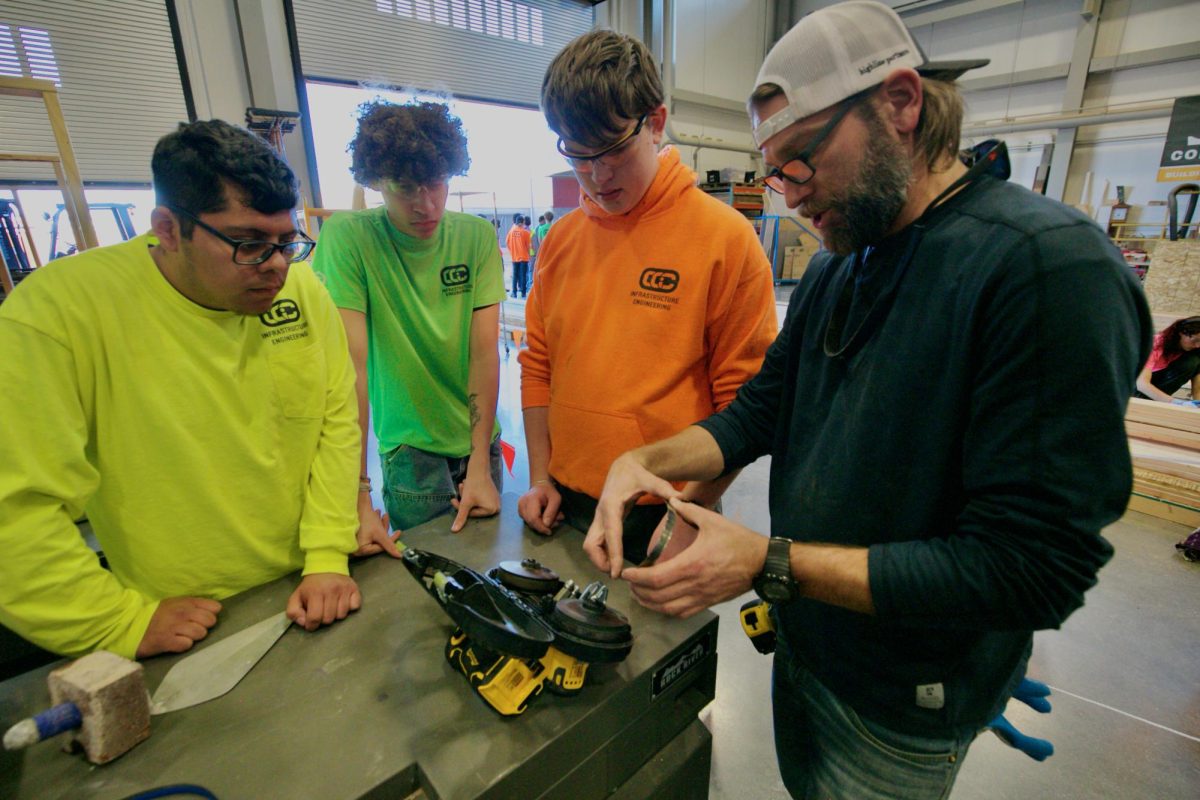The number of transgender people in the nation grows every year, and so does the population of trans students at Creek. For trans kids, every day is a battle between their outer and inner selves, every new face another person they have to come out to. They walk through the halls with a spotlight on their backs. A simple thing like a name is a massive source of stress. Here is what a few of them have to say.
The Trans Student Experience
By Copy Editor Aurora Miller
The experience of trans students is a paradox. They are constantly thrust into the blinding spotlight by their peers and identity, but few people know the full extent of what it’s like to be a transgender kid at Creek. People are too eager to tell trans kids how to feel and too unwilling to listen to their side of the story.
“I kind of dislike it when cisgender people give their own two cents on trans issues,” Hernandez said. “They’ll never understand what it is to live as a trans person in America.”
Adults have a tendency to tell kids how to feel about things, or to push off their experience as a phase and therefore unworthy of being addressed.
“It’s things like ‘You’re too young for labels’ that really get under my skin,” Henke said.
In sophomore Bee Henke’s experience, uneducated people are most likely not going to listen to them regarding transgender issues. “I mostly avoid the topic altogether,” they said.
Sometimes the issue is less about not understanding, and more about having never the topic at all.
“Some have never met a trans person before,” senior Karter LaBarre said. “So I sometimes have some educating to do. Let me tell you about a little thing called gender dysphoria.”
Dysphoria is the sense of distress caused when there is a difference between a person’s gender identity and sex assigned at birth. Dysphoria is so central to the day-to-day existence of trans people, and it’s difficult for cis people to understand it.
“Dysphoria for me is a bruise,” Henke said. “You get punched, deal with the shock, and then it’s over. But later you realize, ‘Ow. That really hurts.’”
Even simple things like going to the bathroom are risky, stressful, complicated endeavors for trans students.
“I always prefer to just use a gender neutral bathroom,” senior Raina Hernandez said. “I refuse to use the men’s restroom, but whenever I go into the women’s room, I have this anxiety that someone will try to hurt me if I’m visibly trans.”
Gender neutral restrooms are the safest and most comfortable for trans and non-binary students, but the fact that there are only four in the whole school makes using them a logistical nightmare.
“Sometimes I’m tardy to class because the gender-neutral bathroom isn’t next to my classroom,” Henke said. “Sometimes it’s just downright defaced, and it can be a hassle if your business happens to come up during passing period.”
None of these concepts are easy to understand to those who haven’t lived them, and it’s far too often that this lack of knowledge tips over into transphobic bullying. The nature of being trans means that every transphobic interaction is a deeply personal attack, and those interactions are plentiful in the hostile high-school environment.
“My things were stolen because I dressed overly androgynous,” Henke said. “I’ve been called slurs when holding my significant other’s hand. If I talked about all of my experiences in detail, we’d be here all day.”
Hallways are a particular magnet for transphobia. Every day is a new rush of strangers, and an insult thrown in the halls is likely to be disciplined.
“There’s a sense of dread,” Henke said. “Is this the day they stare, bark, or call me a f*****, or is this the day they leave me alone?”
Avoiding confrontation in these scenarios is the safest thing to do, but also allows transphobic students to continue their behavior with little consequence.
“If something happens, you don’t stop,” LaBarre said. “You ignore it and walk away because there’s nothing else you can do.”
There’s little that a trans student can do to avoid this negative attention. Passing periods and times outside school hours are particularly dangerous.
“I was running the Spectrum booth at the homecoming carnival last year,” Hernandez said. “A group of boys decided to throw rocks at me and my co-president and were yelling slurs. It’s scary knowing that anywhere I go, I’m not 100% safe. Staff can’t always be around to stop things like that.”
Even classrooms aren’t an escape from hostility. Days that trans students have to deal with a substitute who doesn’t know them are painful and nerve-wracking.
“I was newly out and we had a substitute in class that day,” Henke said. “I kindly said ‘Here, but I go by Bee’ when they called on me. The next student in attendance decided to mock me and say ‘Here, but I go by Toaster’. I felt my face go red and my body started to crumble.”
Experiences like this aren’t uncommon, and in the fast-paced environment of high school, responding is especially difficult.
“I don’t like one-on-one confrontation in a classroom setting,” Henke said. “It means I can’t take a second to regain my footing.”
Luckily, sometimes adults are able to recognize the situation and give students some support.
“I was about to have a dysphoria-induced panic attack,” Henke said, “But then the sub said, ‘I’ve only been a substitute at this school for a couple of years, but I’m aware that this school treats everyone here with respect. This is a warning.’”
Every bit of support counts, especially because the voices of transgender people are often overshadowed by cisgender voices, many of which don’t understand the gravity of trans issues.
“You can’t just say we’re equal when we’re not,” LaBarre said. “The whole reason we’re fighting is because we’re not equal. We’re a minority, and sometimes it’s easy to forget that when we surround ourselves with other queer people.”
Things like Spectrum and other activism clubs are a great way to give minority students a voice.
“Being able to do the work that we do at Spectrum has really empowered me,” Hernandez said. “It’s empowered me to speak for other people like myself and try to move towards a better future.”
It’s time that people heard about what it’s like for trans kids at our school, and trans students are starting to speak up.
“I don’t usually speak about these things openly,” Henke said. “I’m scared of making too much of a ruckus. But this isn’t just for me, it’s for all of my trans friends too. So I’m ready to make some noise to be heard.”
How the Name Change Process Is an Obstacle
By Editor-in-Chief Carly Philpott
A major piece of the trans experience is choosing a name that better fits your identity than the one you were legally given. While not all trans people change their names, it can be an important step in affirming their transition. At school, there are a few places where names appear, and some are more difficult to change than others.
It’s not too difficult to switch your name in the yearbook or on IDs, students report.
“Changing it on the ID and yearbook was so easy,” senior Raina Hernandez said. “All you have to do is go to Activities and ask them to change it and then it’ll all be good.”
According to Yearbook advisor Michelle Scott, the process of changing a name in the yearbook involves submitting a form to the Activities office by the end of November. She says having the correct names is vital to having an accurate yearbook.
“[The yearbook] is an item meant to contain the experiences and memories for that school year. In order for the book to accurately tell the stories of this year it needs to represent students and who they are,” Scott said. “A person’s name is so closely linked to their identity and personal story, and if it is not accurate in the yearbook, then we don’t have an item that truly records Creek’s history.”
Where it gets more difficult is on official, district-run platforms. The name students were originally registered under is what appears on PowerSchool, Google, Schoology, student rosters, and anything else connected to district databases. This forces trans students into sometimes difficult situations, correcting teachers or fellow students when the wrong name is used. And it puts uncomfortable interactions at the front of many kids’ relationships with teachers or other school adults.
“Before school starts I have to email all my teachers and say, ‘Hello, my name is Karter. I use he/him pronouns. Please respect it. Thank you. Bye,’” senior Karter LaBarre said. “And then it’s like a 50/50 shot as to whether it helps. Sometimes they respond. Other times, they just don’t respond. And then I don’t know if I’m gonna get deadnamed in class.”
Some teachers use forms at the beginning of the semester for students to input their correct name and pronouns. This erases some of the direct uncomfortability, but doesn’t fix everything.
“I had this anxiety of going in for the first day and being called the wrong name and having to say ‘Hey, I actually go by Raina,’” Hernandez said. “It honestly made me sick sometimes. I hated thinking about it.”
And while teachers may learn a student’s name and use it correctly, that doesn’t always extend to other adults in the classroom.
“Personally, I get annoyed every time there’s a sub[stitute],” LaBarre said. “I have to tell them I go by Karter. And then they read my dead name anyway. And I’m like ‘I go by Karter,’ and they go ‘Oh, whoopsie I forgot.’ And I’m like, I told you this so I would not get deadnamed in the middle of class. And when the sub does that, everyone just turns around and looks at you.”
To change their name on PowerSchool, students go through their counselor, who then connects the student with the Registrar Office at school. Vice Principal Marcus McDavid is the administrator who oversees the Registrar.
McDavid works with students and their parents to make the decision to change a name on PowerSchool. Recently, the district implemented a new system of changing names in PowerSchool, where registrars will work directly with students, rather than just counselors.
Under the new system, implemented near the end of first quarter, McDavid will now work with every single student requesting a name change, rather than just processing the paperwork. Once these meetings are done, the actual name change isn’t difficult, McDavid says. It’s “just about pushing a button,” McDavid says, done by either McDavid or Principal Ryan Silva. But what can become a roadblock for many students is who has to be involved with the decision: legal guardians.
“You need to have both of your parents sign off on it,” sophomore Bee Henke said. “If I really asked, I could probably get one of my parents on board. It’s a little uncomfortable to think about.”
For Henke, parent involvement makes changing their name not plausible. But that’s not all that can stand in the way. Another roadblock is that changing a name in PowerSchool can conflict with out-of-school records, like test scores.
“It took me longer to get my SAT scores; I waited until late July to get my SAT scores,” Hernandez said.
Even for school records, having a different name on paper for different school years can make sending documents to colleges a challenge.
“Counselors said name change can mess up your entire college application process,” LaBarre said. “All of your past few years’ grades will be under your deadname, and new things are gonna be with this new name, and it might just not show an academic record for the past few years. It’s just a pain. There’s so many things, and red tape, red tape, red tape.”
McDavid hopes that even when it’s not possible to get an official name change, adults at school will still be respectful of student’s preferences.
“If we want to make a change in PowerSchool, we have to have a parent agree,” he said. “However, if the parent doesn’t agree, I think that there are plenty of educators here who, when a kid walks up to us and says, ‘My name is such-and-such,’ we’re gonna honor that.”
Nonetheless, changing an official name in PowerSchool can be an important step for trans students to feel more safe and comfortable in school, and not having the ability to do it can be extremely uncomfortable.
“I do not have my name changed in PowerSchool,” Henke said. “It’s very dysphoric and distracting from important schoolwork sites such as anything Google .”
And for students who have been able to make the change, it can be relieving to remove the step of manually reporting the correct name to everyone.
“People call me by my actual name now and I don’t have to correct subs, it’s great,” Hernandez said.
Counselor Susan Swisher works with students on name change, and emphasizes the importance of the process for students’ identities.
“Some students may have strong emotional responses to their legal names and it can be difficult or painful for them to be addressed in school by their legal names,” Swisher said via email. “For students who have carefully thought through the process, I think the opportunity to make the name change can help support them mentally and emotionally.”

Swisher has worked with many students on the process, but specifically recalls one student she helped with the name change process even when it was delayed.
“I worked with a student and parents prior to the student starting high school. At that time (several years ago), the process in the district was fairly new and we had very little experience with it,” Swisher said. “I knew it was going to take some time to sort out before the change would be made in Powerschool, so I communicated with all of the student’s teachers before the school year started and requested that they use the preferred name and gender so that the student could start the first day of classes being known by this new name.”
Challenges like this in the process still make it too difficult for some students, sometimes preventing them from trying it at all.
“I talked to my counselor about [the name change] last year, I said ‘I want to get my name changed in Power School and on my ID and everything,’” LaBarre said. “We had multiple in-depth conversations about it. I got the form and everything. And then I ended up deciding not to do it.”
Swisher says that sometimes the official process can be too complicated, and suggests an alternative.
“Because this process can be complicated, it seems like offering an option that would meet the needs of some students is to allow students to list a ‘preferred name’ in Powerschool,” Swisher said. “This might be appropriate for students who still want to keep their legal name, but may wish to be called by their middle name or a different first name rather than their legal first name.”
So what do students wish was different?
Some say that just having the ability to switch a name on some platforms, such as Google Drive, would make a difference. Often, when students work with classmates on projects, their Google name is immediately visible, even if it’s not the name students wish to be known by. This can lead to discomfort and alienation. On non-school accounts, users can change the name associated with their Google [word] whenever they want. But the district network prevents students from doing this, even if some say it would help fix the problem.
“I would like to be able to have at least the Google aspect of name changing open to students,” Henke said. “Maybe there should be a wall where you have to talk to your counselor about opening it?”
Some students also wish the process of changing a name on district databases was just easier as a whole. It can often feel unnecessarily complicated.
“Make name change easier,” LaBarre said. “Come on. It’s such a nonsense process.”





![Students perceive each other in highly critical ways.
This is only magnified when the person being observed is transgender. Sophomore Aram Bazarian sat with a trans pride flag for our cover in an all too familiar position. As a trans person at Creek, Bazarian often feels isolated from students around him, not only because of his identity, but also because of the possible hate he could experience for being himself. “Some [students] have never met a trans person before,” senior Karter LaBarre said. “So I sometimes have some educating to do.” Educating their peers is the tip of the iceberg for these trans students. Name-changes, basic respect, and deadnaming are all part of the trans experience.](https://unionstreetjournal.com/wp-content/uploads/2022/11/USJOpt5Edit.jpg)





